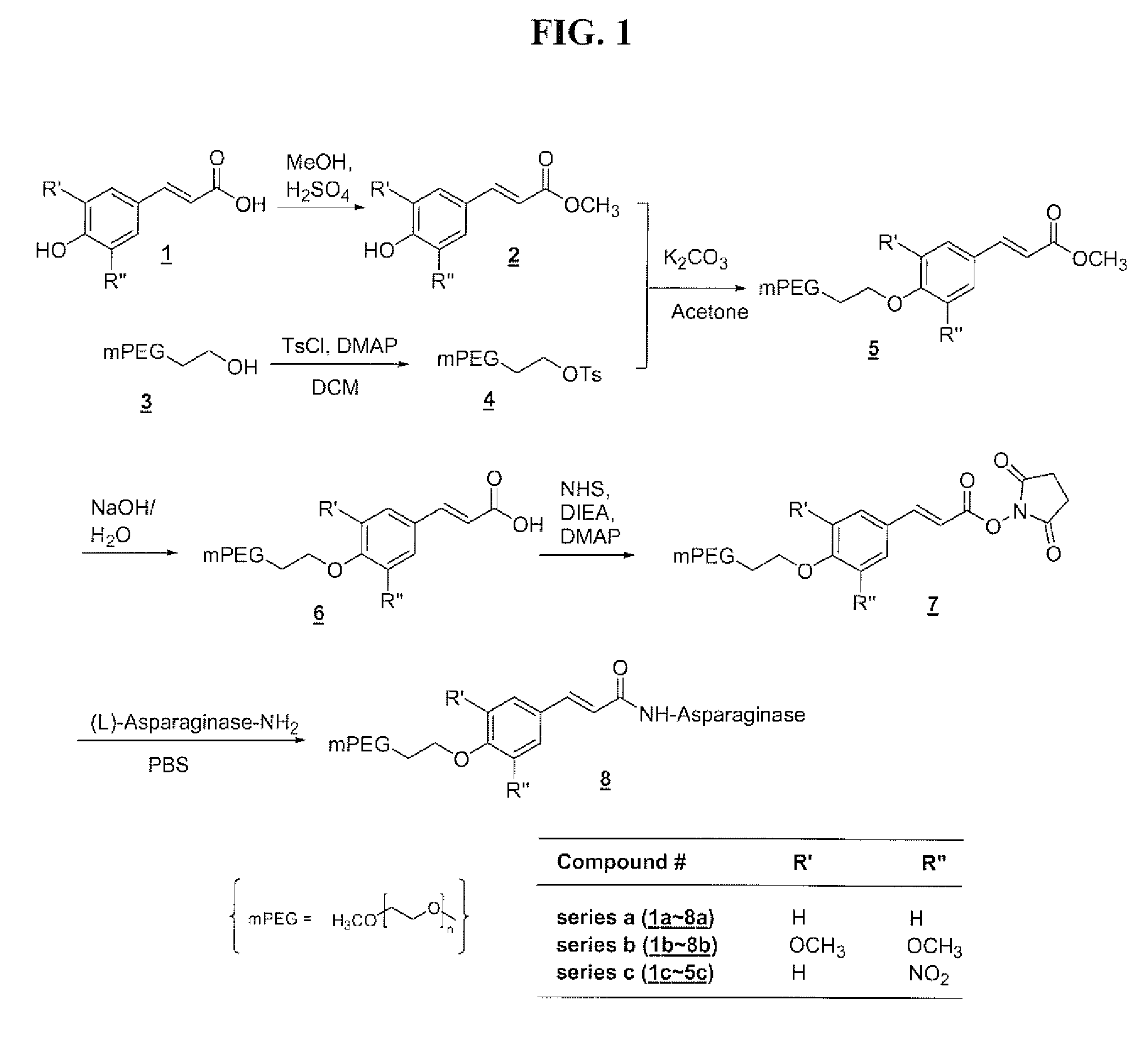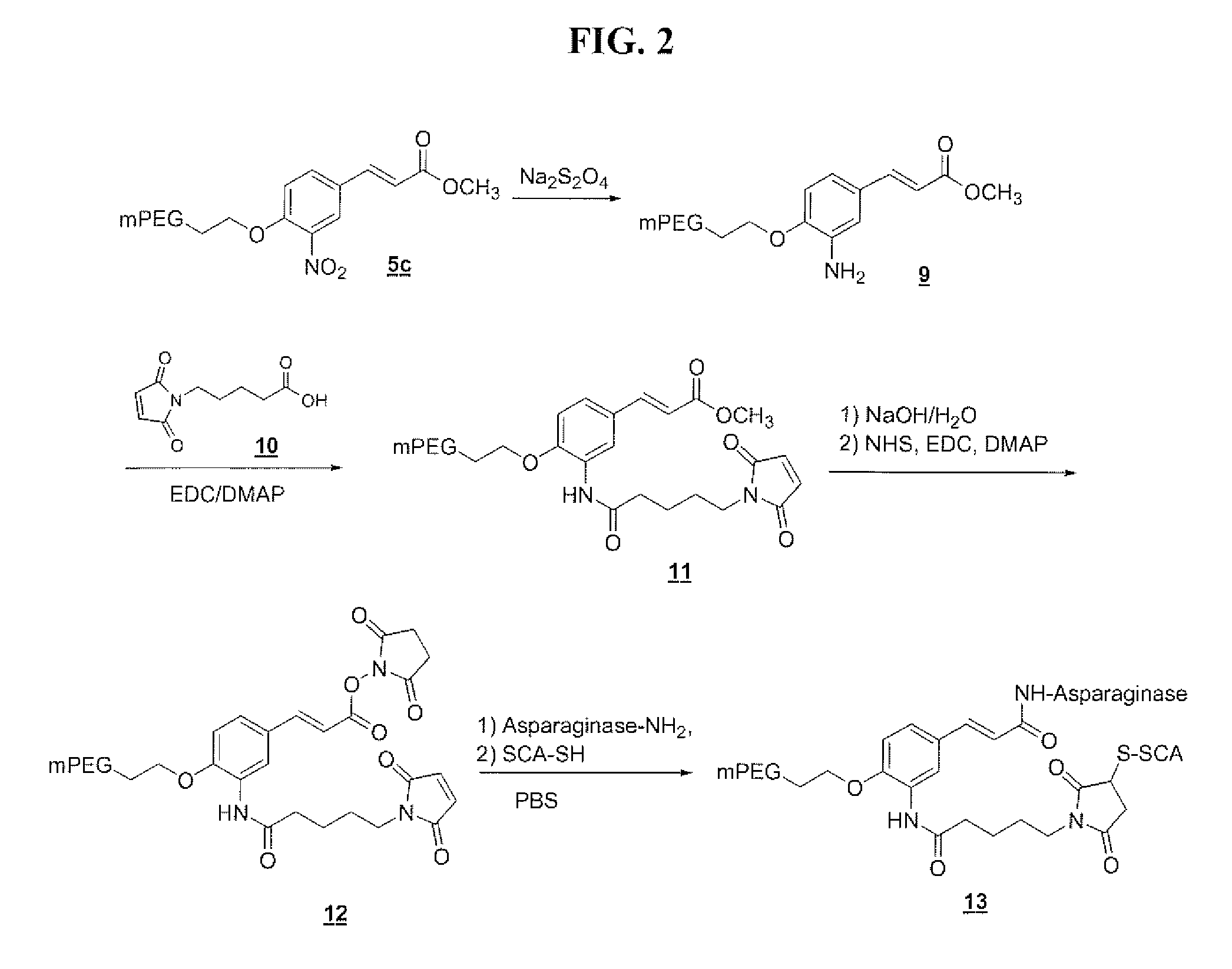Polymeric drug delivery systems containing an aromatic allylic acid
a technology of polymeric drug delivery system and aromatic allylic acid, which is applied in the direction of drug composition, peptide/protein ingredients, organic chemistry, etc., can solve the problems of difficult solubilization of medicinal agents such as alkaloids, and proteins are often prematurely degraded upon administration into the body, so as to eliminate the steps for activating the polymeric system and avoid the multiple steps previously required to attach a second agent
- Summary
- Abstract
- Description
- Claims
- Application Information
AI Technical Summary
Benefits of technology
Problems solved by technology
Method used
Image
Examples
example 1
4-Hydroxycinnamic Acid Methyl Ester (Compound 2a)
[0291]A solution of 4-hydroxycinnamic acid (compound 1a, 20.0 g, 0.12 mol) and 5 drops of concentrated sulfuric acid in 500 mL of reagent grade methanol was stirred for four days at 55° C., while monitored by TLC. The solvent was then removed from the reaction mixture on the rotovap and the solid residue was recrystallized from a mixture of 200 mL of ethanol and 200 mL of water to give 13.3 g of product in 61% yield: 13C NMR (75.4 MHz, CDCl3) δ 168.18, 157.88, 144.85, 129.95, 126.91, 115.86, 114.87, 51.81.
example 2
MPEG5K Tosylate (Compound 4)
[0292]A solution of toluenesulfonyl chloride (21.5 g, 113 mmol) in 50 m-1 L of DCM was added to a solution of mPEG5K-OH (compound 3, 113.0 g, 22.6 mmol) and of DMAP (14.1 g, 116 mmol) in 700 mL of DCM at room temperature over a period of 5 hours. This reaction mixture was then diluted with 500 mL of DCM and washed with 0.1N HCl twice. The DCM layer was dried over anhydrous sodium sulfate and filtered. The solvent was partially removed on the rotovap and the crude product was precipitated by adding ether, collected by vacuum filtration, and washed with ether. This crude product was recrystallized from 12% DMF / IPA (v / v) to give 105.0 g of product in 90% yield: 13C NMR (75.4 MHz, CDCl3) δ 144.18, 132.50, 129.31, 127.42, 71.49-68.22 (PEG), 58.36, 21.32.
example 3
mPEG5K Cinnamic Acid Methyl Ester (Compound 5)
[0293]A mixture of mPEG5K tosylate (compound 4, 40.0 g, 7.76 mmol), 4-hydroxycinnamic acid methyl ester (compound 3, 13.0 g, 73.0 mol), and anhydrous potassium carbonate (10.1 g, 73.4 mmol) in 400 mL of reagent grade acetone was refluxed overnight, followed by removal of the solvent from the reaction mixture on the rotovap. The solid residue was dissolved in DCM and washed with 0.2N HCl twice. The DCM layer was dried over anhydrous sodium sulfate and filtered. The solvent was partially removed on the rotovap and the crude product was precipitated by adding ether, collected by vacuum filtration, and washed with ether. This crude product was recrystallized from 12% DMF / IPA (v / v) to give 38.2 g of product in 95% yield: 13C NMR (75.4 MHz, CDCl3) δ 167.18, 160.16, 144.04, 129.28, 126.79, 114.92, 114.58, 71.63-67.25 (PEG), 58.74, 51.30.
PUM
| Property | Measurement | Unit |
|---|---|---|
| Mass | aaaaa | aaaaa |
| Mass | aaaaa | aaaaa |
| Mass | aaaaa | aaaaa |
Abstract
Description
Claims
Application Information
 Login to View More
Login to View More - R&D Engineer
- R&D Manager
- IP Professional
- Industry Leading Data Capabilities
- Powerful AI technology
- Patent DNA Extraction
Browse by: Latest US Patents, China's latest patents, Technical Efficacy Thesaurus, Application Domain, Technology Topic, Popular Technical Reports.
© 2024 PatSnap. All rights reserved.Legal|Privacy policy|Modern Slavery Act Transparency Statement|Sitemap|About US| Contact US: help@patsnap.com










